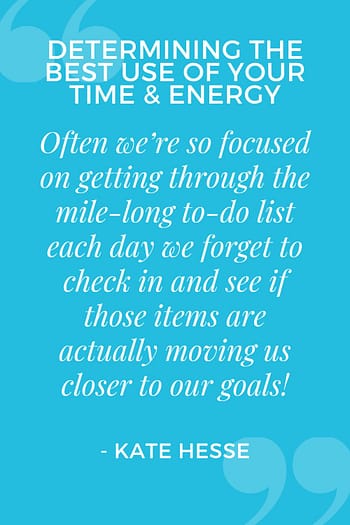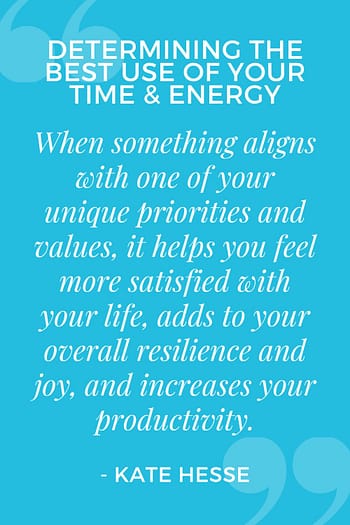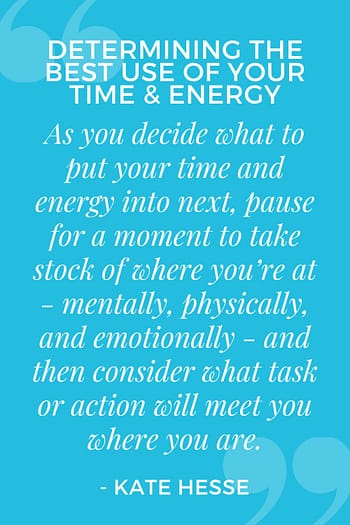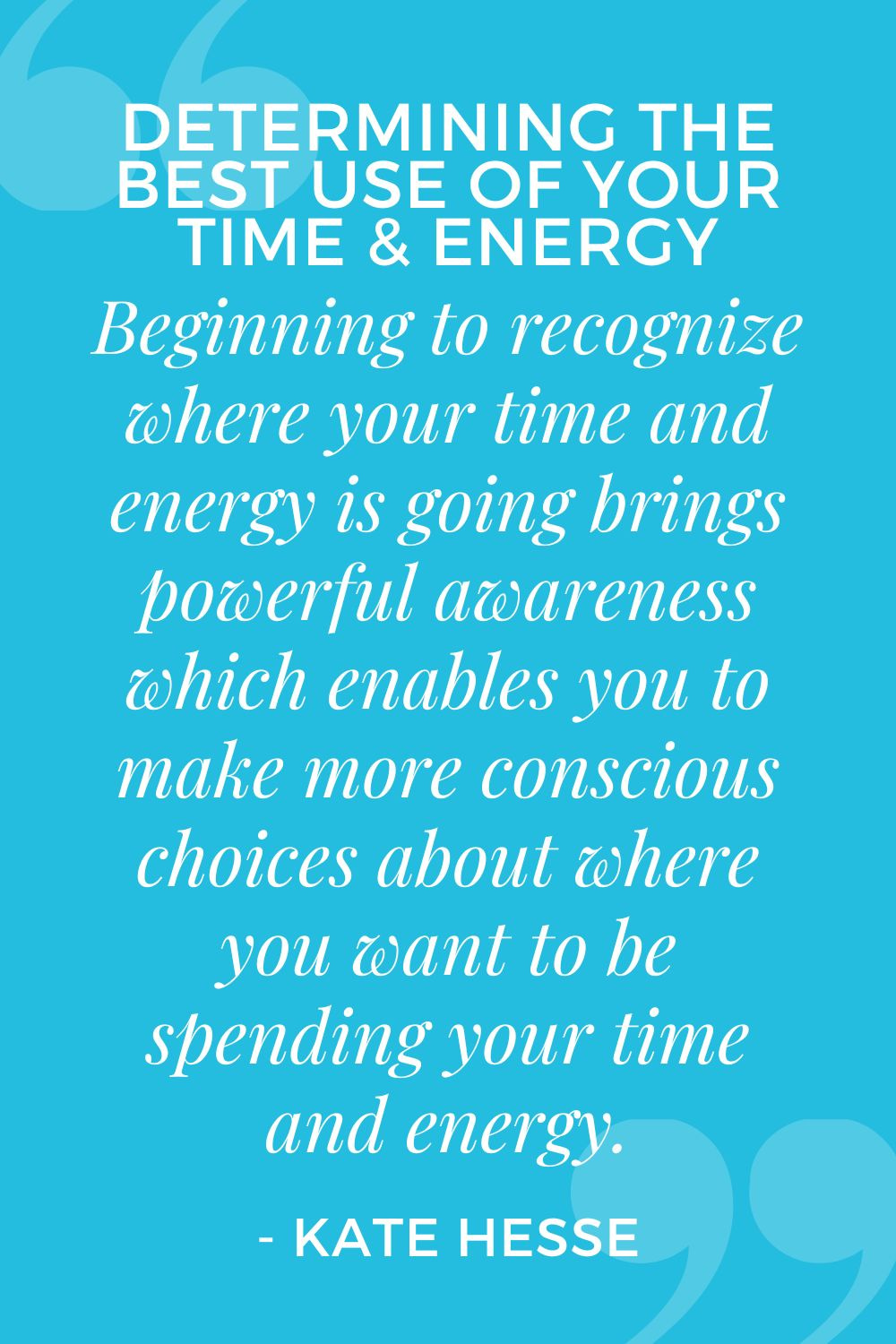
Boundaries help you preserve your time, energy, and other resources for the things you want and need to do. But key to creating boundaries is determining what those things are that you’re preserving your energy for! Without some process for identifying what’s truly important to you, it will be hard to know where to focus your time and energy!
There are a lot of moving parts which come into play when identifying where to focus your time and energy. I’ve covered several of them in past posts, so I’ll be referring back to past podcast episodes where you can get more information on the different tools and techniques which can help you decide where to put your time and energy. You can also get the Worksheet with all the links and more using the form below.
What are your goals
 The first component in determining where to focus your time and energy is identifying your goals.
The first component in determining where to focus your time and energy is identifying your goals.
This might sound obvious, but often we’re so focused on getting through the mile-long to-do list each day we forget to reflect back on how each of those to-do items move us closer to our goals. Or just as often, why we’re doing the items which don’t get us any closer to our goals.
Maybe you have a routine goal setting practice and can point to a piece of paper tacked up on a board in your office with goals in several aspects of your life. Or maybe you’re struggling to come up with a single thing you would identify as a goal in any aspect of your life.
No matter where you fall on this spectrum, if you need help creating or reviewing your goals, check out Episode 3 of Solicited Advice to Live Your Best Life. We did a deep dive into goal setting and there’s an awesome companion worksheet for that episode which helps guide you through the process of setting your goals.
How does each item on your to-do list support your goals
Once you have your goals, you can use them as a filter for each item on your to-do list, or each task that comes up throughout your day.
When you’re trying to decide the best place to focus your time and energy, prioritize those tasks and actions which will move you along the path toward realizing your goals.
Recognize this might not be a clear line between the task and the goal. For instance, if your goal is to eat healthier, then going to work each day will help you achieve your goal by providing the finances to purchase the healthy food. But, continuing with the same goal, taking a class on donut making might not be the best use of your time and energy – unless I suppose your job is as a baker.
What are your unique priorities and values
 I’ve talked about these several times in the past, but understanding your unique priorities and values is another key filter to help you identify the best things to spend your time and energy on.
I’ve talked about these several times in the past, but understanding your unique priorities and values is another key filter to help you identify the best things to spend your time and energy on.
If something you’re doing aligns with one of your unique priorities and values, it will help you feel more satisfied with your life. It will add to your overall resilience and joy. And it will often be something which feels easier to follow-through on resulting in an overall increase in your productivity.
Again, this might be something you’ve got written on a worksheet and are ready to go. Or it might be something you’re struggling to pull into clear statements. If you need additional support in clarifying your unique priorities and values, check out Episode 24 of Solicited Advice to Live Your Best Life and grab the companion worksheet which guides you through this process.
Focus on actions aligned with your unique priorities and values
Once you’ve identified your unique priorities and values, use this as another filter to pass each item on your to-do list through. When things are out of alignment, can you simply release them or delegate them to someone else?
Additionally, as things come up throughout the day, run them through this filter recognizing that as with your goals, this might not always be a clear and direct connection. For example, if entertaining friends and family in your home is one of your unique priorities, decluttering your home might be a task which makes it easier and more comfortable to follow through on that priority.
What do you need in this season, today, in this moment?
 When you’re deciding the best way to spend your time and energy, recognize this won’t be a static decision. Not only will your goals and unique priorities evolve over time, but you’ll also find a number of other factors will impact what you need in any given moment.
When you’re deciding the best way to spend your time and energy, recognize this won’t be a static decision. Not only will your goals and unique priorities evolve over time, but you’ll also find a number of other factors will impact what you need in any given moment.
A few additional filters to use as you consider what tasks and actions to undertake:
- What is your energy level?
- What do you need more of and less of today or in this moment?
- How focused and/or distracted are you right now?
The activities which are the best use of my time on a day I wake up with a migraine are going to be really different than the activities which would be the best use of my time on a day I wake up feeling great. Similarly, if I’m struggling to focus, it’s probably a better use of my time to run errands off a list I wrote earlier in the week than to sit down and try to write a podcast script.
And you may also find that moving in harmony with natural rhythms offers another tool to help you filter the best way to focus your time and energy. Check out Episode 15 of Solicited Advice to Live Your Best Life for more on planning your schedule around the the rhythms of nature.
Focus on what tasks meet you where you’re at
The reason using these filters is so impactful is they help you focus on the tasks you’ll be most productive at. The best use of your time is often to do things in the most efficient way possible.
Let’s go back to the example of struggling to focus. If I can’t keep my thoughts on what I’m writing, it will take me exponentially longer to write a podcast script. That time would be much better spent taking care of tasks which don’t require a large amount of focus – I actually keep a “creative” and “mechanical” list of tasks – it helps me to easily select something which needs to be done – AND meets me where I’m at to maximize my productivity.
There will be times when you need to adjust the activity – when I wake up with a migraine, going out in the garden in the full sun and heat is only going to make it worse. But doing a mind dump onto paper or listening to a Yoga Nidra will help me release mental tension and in turn ease the migraine so I can get to other tasks once the migraine is gone.
As you decide what to put your time and energy into next, pause for a moment to take stock of where you’re at and then consider what task or action will meet you where you are.
What needs to be done?
One final filter to consider is what needs to be done – what are the non-optional things?
This might be laundry when you’re wearing your last clean pair of socks. Or it might be the self-care activities which help you feel energized to take on all the other tasks on your to-do list.
You might be surprised to find I’ve included self-care under the non-optional activities. Sometimes it might fall under one of the other categories we’ve already covered. But I’ve noticed with many of my coaching clients, self-care is something we tend to push to the bottom of our priority list thinking it’s optional or we just don’t have the time for it.
The truth is though, without consistent, sufficient, and sustainable self-care, you simply won’t have the energy, resilience, or mental and emotional fortitude to tackle all the other things on your to-do list. This makes self-care truly non-optional. If you need help figuring out the best way to incorporate self-care into your every day, check out Episode 4 of Solicited Advice to Live Your Best Life and get your copy of my free Self-Care Toolkit.
Where are you spending your time and energy now?
 All of the filters we’ve covered so far are about consciously evaluating how you spend your time and energy. But the reality is so many of us spend time without consciously realizing it. Just take a minute and check your phone usage for the last day or two – on an Android you can do it in Digital Wellbeing, on an iPhone it’s under Screen Time.
All of the filters we’ve covered so far are about consciously evaluating how you spend your time and energy. But the reality is so many of us spend time without consciously realizing it. Just take a minute and check your phone usage for the last day or two – on an Android you can do it in Digital Wellbeing, on an iPhone it’s under Screen Time.
Before you look at your stats, take a minute and jot down what you think the answers are to these questions on a piece of paper:
- How many hours were you on your phone?
- What apps were you using most and for how long?
- How many times in a day do you unlock your phone?
Now compare your estimates to the actual numbers. Chances are you’ve underestimated on each of these items.
Beginning to recognize where your time and energy is going brings powerful awareness which enables you to make more of those conscious choices about where you want to be spending your time and energy.
To do a deep dive into this, I suggest conducting a personal energy audit. That link will take you to a blog post where you can also download a companion worksheet to guide you through the process.
The best places to put your time and energy
So to review – use a few filters to help you determine the best places to put your time and energy. What tasks support your goals, align with your unique priorities and values, meet you where you’re at, and/or are non-optional.
Additionally, identify the areas where you engage with less conscious awareness so you can bring more attention to making a thoughtful decision about what you actually want to be doing with that time and energy.
We’ve covered a lot! Don’t forget to get the companion worksheet which includes this framework for deciding where to focus your time and energy as well as links to all the resources I mentioned in this post – you can grab your copy using the form below.
And remember – living your best life isn’t about changing your life – it’s about changing the way you show up for your life!
Show Notes
Mentioned in this Episode
Dive into goal setting.
Identify your unique priorities and values.
Harmonize with nature’s rhythms here and here.
Construct a consistent, sufficient, and sustainable self-care routine.
Get the Free Self-Care Toolkit.
Schedule a Personal Roadmap Discovery Session.
Get on the VIP list to have all podcast worksheets delivered to your inbox each Tuesday morning.
Submit your question to be featured on a future episode.
Related
One thought on “5 Tools to Help You Determine Where to Focus Your Time & Energy”
Leave a Reply Cancel reply
This site uses Akismet to reduce spam. Learn how your comment data is processed.
[…] find yourself standing in your own way! If you’re struggling with this part of the process, check out last week’s episode where we covered how to know where to put your time and […]